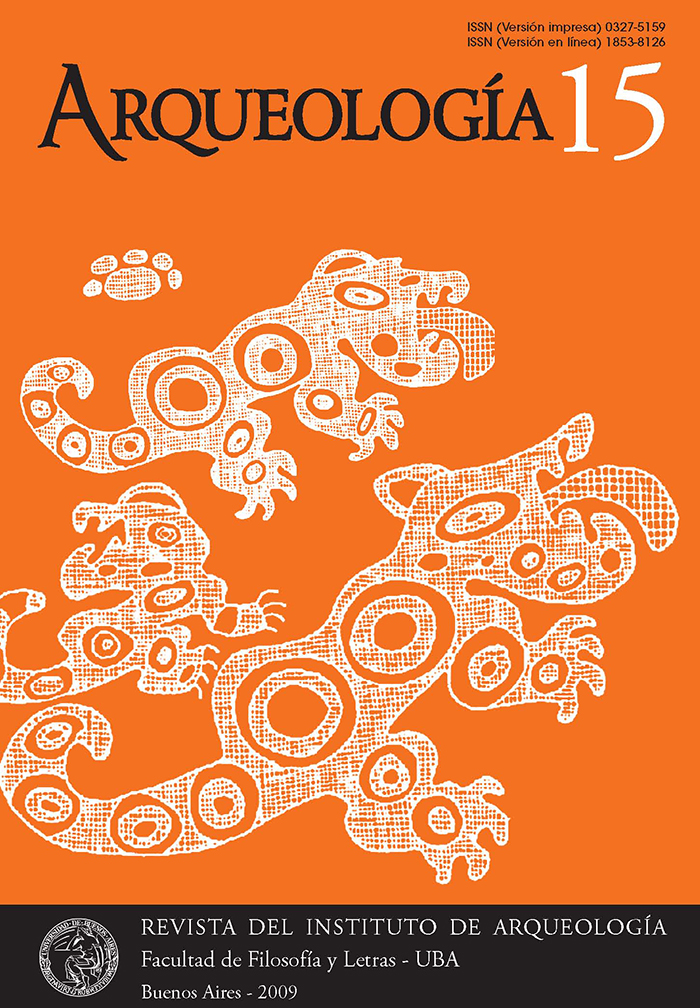Los contextos funerarios de Azampay entre el Período de Desarrollos Regionales y la conquista inkaica (Valle de Hualfín, Catamarca)
Palabras clave:
Contextos Funerarios, Valle De Hualfín, Azampay, Período De Desarrollos Regionales, Conquista Inkaica
Resumen
En este trabajo se analizan los contextos funerarios del área de Azampay y alrededores (Valle de Hualfín, Belén, Catamarca) correspondientes a los últimos momentos de la historia precolombina, adscriptos mayormente a la denominada “cultura Belén” utilizando la información de las distintas investigaciones llevadas a cabo en la zona. Se clasifican las tumbas de acuerdo a sus características constructivas, número individuos inhumados, sus ajuares funerarios y la disposición de los mismos. Aplicando el concepto de límite, definido como barrera conceptual entre dos lugares, estados legales o cualidades, se estudian las similitudes y las diferencias en las modalidades de construcción y en la concepción de los espacios funerarios. Los resultados del análisis permiten afirmar que los límites físicos dados por las tumbas bajo bloque con pircados externos y las demás estructuras cerradas, constituyen límites conceptuales entre el espacio funerario y no-funerario. Finalmente, teniendo en cuenta las diferencias observadas con respecto a distintas tumbas Belén de otras localidades del Valle de Hualfín que incluyen piezas inkaicas, se propone a modo de hipótesis que en el ámbito de la muerte la influencia inka generó un cambio en la conceptualización de los espacios funerarios de las sociedades locales.Descargas
La descarga de datos todavía no está disponible.
Cómo citar
Wynveldt, F. (1). Los contextos funerarios de Azampay entre el Período de Desarrollos Regionales y la conquista inkaica (Valle de Hualfín, Catamarca). Arqueología, 15, 127-147. Recuperado a partir de http://revistascientificas.filo.uba.ar/index.php/Arqueologia/article/view/1701
Número
Sección
Artículos
Los autores/as que publiquen en esta revista aceptan las siguientes condiciones:
- Los autores/as conservan los derechos de autor y ceden a la revista el derecho de la primera publicación, con el trabajo registrado mediante Licencia Creative Commons 4.0 Internacional (CC-BY-NC-SA), que permite a terceros utilizar lo publicado siempre que mencionen la autoría del trabajo y a la primera publicación en esta revista.
- Los autores/as pueden realizar otros acuerdos contractuales independientes y adicionales para la distribución no exclusiva de la versión del artículo publicado en esta revista (p.e. incluirlo en un repositorio institucional o publicarlo en un libro) siempre que indiquen claramente que el trabajo se publicó por primera vez en esta revista.
- Se permite y recomienda a los autores/as a publicar su trabajo en Internet (p.e. en sus sitios web personales o en depósitos institucionales), tanto antes como después de su publicación en esta revista, siempre y cuando proporcionen información bibliográfica que acredite, si procede, su publicación en ella. De esta manera, pueden favorecerse intercambios productivos y a una mayor y más rápida difusión del trabajo publicado (vea The Effect of Open Access).



.png)

(1)13.png)






1.jpg)
1.png)
1.jpg)


13.png)
1.png)


(1)1.png)









